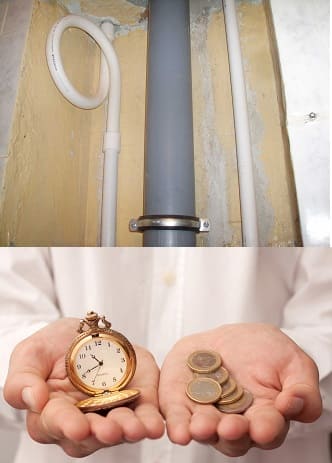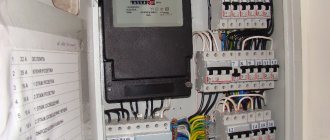The privatization of apartments in an apartment building has largely changed the rules for the use and repair of utility systems that provide the house with the necessary living conditions.
Not all residents know what they must repair and maintain at their own expense, and what elements of the heating, sewerage or water supply systems must be repaired by the housing office or the management company servicing the building.
Most often, questions arise when replacing or repairing a sewer riser. According to the law, replacing the sewer riser in an apartment is the responsibility of housing and communal services.
This is indicated in the relevant articles of the Civil Code of the Russian Federation, which should be referred to when drawing up applications for replacement work. The rules for using the joint property of the house determine that such work as replacing heating risers is carried out by the Management Company.
When should replacement be carried out?
The service life of sewer risers in an apartment building is up to 30 years. This period is determined by the material of their manufacture; previously risers were installed from cast iron.
Modern sewage systems are installed from pipes, for the manufacture of which materials with a longer service life are used. Therefore, their service life is quite long.
Many homes still use outdated cast iron systems whose service life has long expired. During this time, the metal began to deteriorate, and sewer risers and pipes may leak. You should not wait for flooding, which will lead to the need for repair work in several apartments.
Residents of the house have every right to contact the Management Company and raise the issue of replacing sewer risers if their service life has expired. The work must be carried out at the expense of the company, to which residents make contributions under the heading “maintenance and repair of the house.”
Replacement must be carried out as soon as possible under the following circumstances:
- When the collector falls into disrepair.
- When the riser is destroyed due to metal corrosion.
- If an old cast iron pipe exerts strong pressure with its weight on a metal-plastic riser in the apartment below or on the floor above.
Plumbers who service an apartment building always recommend changing the riser on all floors so that it is solid and more reliable.
If cast iron begins to deteriorate in one apartment and leaks appear, after a short time residents of apartments on other floors will encounter the same problems. Therefore, it is worth finding an opportunity to carry out replacement work at the same time. A collective application will only speed up the time it takes to complete the work.
How to properly dismantle the riser?
Before installing a new section of sewer pipe, you need to dismantle the old one.
There are two options:
- the work does not affect floor slabs;
- replacement is carried out with the capture of the area between the floors.
The procedure for dismantling the pipe itself is no different in both cases. The difference lies in the need to open the interfloor ceiling before dismantling the pipe in the second case.
Algorithm for dismantling the sewer riser:
- At a height of 1 m at least from the adjustable fittings, an incision is made on the cast iron pipe with a grinder and the section is removed from the lower socket.
- If the pipe cannot be loosened using a nail puller or chisel, you can try heating it to soften the old sealant.
- The riser is analyzed from top to bottom, from connection to connection.
We recommend that you read: Methods and purposes of using a plug for a sewer pipe
The opening of floor slabs between floors will need to be agreed upon with the neighbors. Dismantling of ceilings is carried out either with a hammer drill or using a crowbar, chisel and hammer.
Note! Work should be carried out without strong impacts, using rocking, heating, and gentle tapping. Excessive physical impact on a cast iron riser can split it.
Legislation
There are a number of legislative norms that residents of apartments in apartment buildings and owners of privatized and non-privatized housing should definitely know:
- According to Article 290 of the Civil Code of the Russian Federation, sanitary networks inside and outside apartments that serve more than one apartment belong to the residents on the basis of common shared ownership. This applies to risers that are common to several apartments; they are the property of the housing and communal services.
- According to Government Decree No. 491 (08/13/06), the drainage system in a house and apartment is classified as public property.
Both excerpts from legislative documents indicate that the sewerage system and its risers do not belong to the resident’s property, it is common property. Therefore, it must be serviced by housing and communal services institutions - the Management Company, Homeowners' Association, Housing Office.
The fact that the change of collectors is carried out by the service authority is also confirmed by the Rules for the operation of a residential building. They indicate that replacement of the water supply system, cold and hot water supply, and drainage system is included in the current repairs of the house.
Replacing risers in a privatized apartment
Replacing risers in your own apartment is a simple procedure. A riser is a pipe that runs vertically through all the apartments located in the house. With the help of such a pipe, residents are provided with gas, as well as hot and cold water.
The risers are used common property, for this reason their repair and necessary replacement are the direct responsibility of the current management company. All financial expenses do not apply to apartment owners.
The riser is repaired free of charge to the point of its connection with the installed pipe distribution system in the interior of the apartment. Then the equipment becomes the property of the tenant and is repaired at his expense.
Sometimes employees of existing operational services claim that the repair of installed risers is the responsibility of the owner, which is why additional payment is required from him.
This is illegal, since residents of privatized properties pay a fee every month for repairs and necessary maintenance. Therefore, the direct owners of the apartments do not pay additional money for replacing the risers.
What to do
The management company does not always show great interest in the condition of the technical equipment of the house. How to force the riser to be changed in this case?
If a drainage pipe, common to many apartments, becomes unusable due to corrosion of cast iron, if leaks appear, there is no need to wait for an emergency, you should contact the Criminal Code, draw up an application for replacement, a sample of which should be in the reception area.
ATTENTION! It is advisable that such an application be from several apartments at once, but it can also be submitted individually.
The application must be registered and accepted for consideration. Representatives of the management company must notify the residents in advance about the time of work, as well as the entire house that repair work will take place in it, and the water will be turned off for a while.
If housing and communal services refuse
When drawing up an application, you must immediately indicate references to legislative acts, according to which the maintenance and repair of this part of the utility systems is carried out by the housing office or the homeowners' association, management company.
Most often, the refusal is due to the fault of the residents themselves. For example, they independently carry out replacements, damage pipes, rearrange the heated towel rail and disrupt the operation of the entire heating system.
In this case, the owner of the apartment must reimburse the costs of repairs. According to the rules, the duty of the Housing Office is to replace the old cast-iron riser with a plastic one. If the pipes were damaged by the residents, they also pay for the repairs.
But the refusal on the part of the housing and communal services institution may be unfounded. In such a case, the applicant or applicants must request that the refusal be in writing. With such a document, you can first contact the manager of the management company or HOA, then Rospotrebnadzor, the Housing Inspectorate. If there is no result from such actions, a statement of claim should be filed in court.
ATTENTION! The court is the final authority; it will certainly require evidence of attempts to resolve the problem pre-trial.
How to change it yourself
Replacing a sewer riser in an apartment begins with studying the sequence of actions.
replacing the riser yourself
At the initial stage of work, old sewer pipes are removed. If replacing the sewer riser in an apartment is carried out in a room located on the 9th, that is, the top floor of the house, then the work is much easier to complete. If repairs need to be done at other levels, then it is necessary to turn off the sewer riser. This can be done only after an official application to the management company or housing office. When water is turned off without approval, the initiator may face big problems.
Ideally, the sewer riser is replaced completely. That is, together with parts of the system located in the ceilings between floors. In this case, the process begins by punching several holes around the riser. One is done from above, the second from below. Such holes will make it easier to dismantle the pipe and replace it with a new element. Naturally, violation of the integrity of the walls requires agreement with the neighbors. If it is not possible to obtain it, then the work will be limited to replacement only in your own living space. True, you can change the design along the entire height.
Installation
In any event, a new one will have to be installed in place of the old riser. To connect vertically located sections of a smooth pipe, each element should be inserted into a socket equipped with a rubber cuff. You can improve the adhesion of the sections using a bar of ordinary soap. The joints are treated with alkali, and it becomes much easier to install the sections.
The sockets should be placed so that their direction coincides with the direction of water flow in the system. In other words, when the slope of the pipeline that comes from the plumbing is located at a level corresponding to the installation rules, then the smooth end of the PVC pipe must be installed in sockets located at a level below. Such actions will prevent clogging with small waste.
In the process of installing a new pipe, it is important during the design to consider the number of future plumbing connections for all fixtures (toilet, sink) that will be installed in the apartment. Each connection point of a tee or branch with the main pipe is made according to the principle used when connecting the main pipeline.
Installing a tee and fastening the riser
Installation of a new riser most often begins with the installation of a tee or lower outlet. The specified structural element must be inserted into the socket. Then the joint should be thoroughly coated with sealed material or a winding should be used. There is always a gap between a vertical pipe and a tee. It is important that it is not more than 10 millimeters. Also, when installing plastic pipes, the use of sliding couplings is not allowed. Only special compensators can be used.
The new riser must be firmly secured to the wall. Therefore, the next stage of work will be the installation of fasteners. If the distance between the sewer riser and the wall is no more than 7 centimeters, then the clamps can be secured to the wall with dowels. If the distance parameter exceeds the specified limit, then you will need to fix the board to the wall. It is important not to forget to saturate the wood with an antiseptic solution or drying oil. If you don’t have a board of a suitable size on hand, it can be replaced with metal corners or other materials. When installing the fastener, the upper clamp must be positioned as close as possible to the socket. The lower clamp should be secured as close as possible to the shaped pipe.
When work is carried out in a typical residential area, three clamps will be required for reliable fixation.
Verification phase
When each part of the new system is installed in its place, and the meters and plumbing are installed and connected, the stage of checking the work performed begins. To do this, it is worth dumping water from each device and monitoring its movement. The absence of leaks and rapid descent indicate a flawlessly completed job.
This completes the dismantling of the old pipe and installation of a new riser. If possible, it is better to hide the riser using decorative lining. It is important to understand that the casing must be removable or have a hatch, since if problems arise with pipes or meters are replaced, full access must be ensured.
Conclusion
When describing common problems associated with repairing and replacing a sewer system, it is worth remembering that it is public property. Therefore, the management company or utility workers from the housing office are responsible for safety and proper operation. However, this is all written down in the rules, that is, on paper. In practice, the problem of repairing or replacing the riser is often shifted to the shoulders of the owners of residential premises. The option of writing a statement does not help either. Naturally, those in charge will officially register the paper and even pretend that they are busy solving the problem. When the start of repairs begins, it can be constantly delayed and it is easier for people to hire a contractor themselves and replace the problematic part.
Considering the fact that the fund for promoting housing and communal services reform, in accordance with article number 185 of the Federal Legislation, is funded by contributions from citizens and repair work must be carried out at the expense of budgetary funds, apartment owners are required to compensate at least 5 percent of the total estimate of the work performed.
Everything useful about sewerage -
GidKanal | Yandex Zen
Does the management company have the right to demand payment?
Such actions of the Management Company violate the law. The apartment owner does not have to pay for labor and materials for the following reasons:
- Sewer risers are common property and are maintained, repaired, and replaced at the expense of the service organization. If we are not talking about replacing a pipe due to the fault of the residents themselves, who damaged it as a result of carrying out the work independently.
- Apartment owners already pay for repairs by transferring monthly funds under the “house maintenance” column. The amount that accumulates through such transfers should pay for ongoing repairs.
When plumbers still insist on payment, you should complain about them first to your boss, then to Rospotrebnadzor or the prosecutor's office.
Who repairs and pays for the work?
Responsibility for the operability and absence of damage to pipe sections and branches located inside the apartment rests with the owner of the residential premises. If there are faults in the specified area, the owner of the apartment must eliminate them on his own. This work is also paid for by the homeowner. An exception to this rule are situations where the apartment has not been privatized or the list of works falls within the scope of actions carried out during major repairs. It is important to remember that you should notify your neighbors before starting any repairs.
Replacement of risers, as well as their repair, which are listed on the balance sheet of the management company or housing office, is carried out at the expense of funds allocated from the budget for the maintenance and repair of residential premises. This fund receives monthly payments from residents in accordance with article of the housing code number 153. Any attempt by public utilities to attract residents of the house to pay for the specified work is considered illegal.
When repairs or replacement of a sewer riser, which is located in common property, are required, and utility workers will undertake the work, then payment is made from funds collected by residents.
How to make an application
There is no strictly established template for drawing up such a statement. Each management company or housing office can develop its own version of the document. But there are general rules that are the same for all housing and communal services institutions:
- First, the name of the management company and the information of the manager (full name) are indicated.
- Then you need to write about the absence of debt on utility bills, confirming with a copy of the receipt.
- Next is a request to replace the riser.
- The application is signed by the owner of the apartment or the owners of all apartments along the riser.
The document is drawn up in at least two copies, one of which must be in the hands of the residents. If the management company does not carry out replacement work within the required time frame, the registered application will become the basis for contacting the regulatory authorities.
At whose expense are the hot and cold water risers in the apartment replaced?
Construction is a very intensive industry in which the interests of many players intersect - developers, owners, contractors and regulatory authorities. As expected, conflict situations arise between them that require going to court. The review of judicial practice includes disputes in construction.
An article has appeared in the Criminal Code regulating the liability of unscrupulous developers who embezzle funds from citizens, leaving them without the promised real estate. Many hours of correctional and forced labor, as well as a real prison sentence, will help stop the development of fraud, legislators are confident.
We recommend reading: From what year were insurance premiums transferred?
Replacing pipes when an apartment is flooded
Sometimes it is necessary to change the riser in emergency conditions, in case of severe sewerage leakage and flooding of the apartment (apartments). What to do in case of an accident? The apartment owner contacts the emergency service, its employees must arrive on site and draw up an inspection report.
IMPORTANT! This act indicates whose fault the leak occurred.
The fault of the Management Company is confirmed if the leak occurred due to rotten, corroded pipes. By law, the service company must monitor the condition of the pipes.
When accepting a house for service, it is necessary to establish what year it was built and when major repairs were carried out. It is not difficult to assume that wastewater drains may already require replacement due to their expired service life.
In the case where the apartment owner himself changed the riser and pipes, did it incorrectly and caused flooding, the blame for what happened lies with him.
Typically, such an act is needed when the insured apartment has been damaged and insurers need to decide who will compensate for the damage.
Reasons why it is necessary to change the riser in the apartment
Since the sewer system in any building with a large number of apartments is constantly tested for strength under increased loads, it requires periodic repairs. The most common problem with pipes is leakage. Of course, the presence of a small crack in the riser can be eliminated through the efforts of a technician who will put a clamp on the damaged area. The same work can be done on your own. However, it is important to remember that a clamp will not get rid of the problem, but will only be a temporary solution. After some time, the damage will make itself felt. Moreover, this can happen with consequences that are much sadder.
The sewer riser needs to be replaced in the following situations:
- The appearance of signs of wear on old pipes (cracks, leaks, chips).
- Installation of a shower cabin without installing a tray.
In addition, replacing the sewer riser is recommended simultaneously with major home repairs. If there are financial opportunities, this is done along with replacing old plumbing and installing new pipes.
By carrying out these procedures together, the apartment owner will receive the following benefits:
- Saving money by hiring a specialist. Calling a specialist once to perform a large volume of work at once will cost an order of magnitude less than calling a specialist several times for each stage of work separately.
- It is much easier to warn and agree with neighbors to turn off the riser one-time than when replacing individual elements of the system, blocking the pipes every time.
- Save time by completing work within one or several days.

saving effort and time
The third advantage can be called the main one, since it is better to spend your personal time on work in the remaining rooms of the home.
Carrying out the procedure yourself
- Interfering with the drainage system (this also applies to water supply and heating) is a responsible and not safe step.
- Replacement of risers can only be carried out with the permission of the management company, when other residents are notified about the work.
- You cannot change the location of this pipe or its configuration.
- Even if it is customary to do the replacement yourself, you still need to invite a qualified plumber to do the work.
- If the riser is covered with plasterboard, an inspection hatch should be left to monitor its condition.
- The telephone number of the control room of the Management Company and the emergency service should always be at hand in the apartment.










